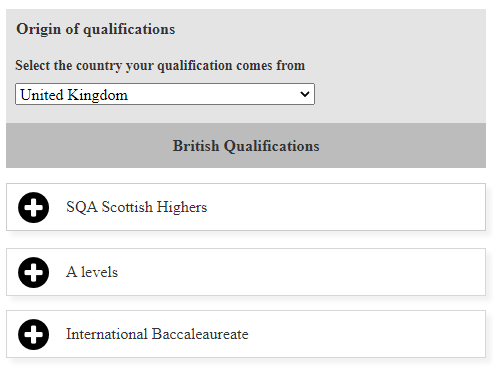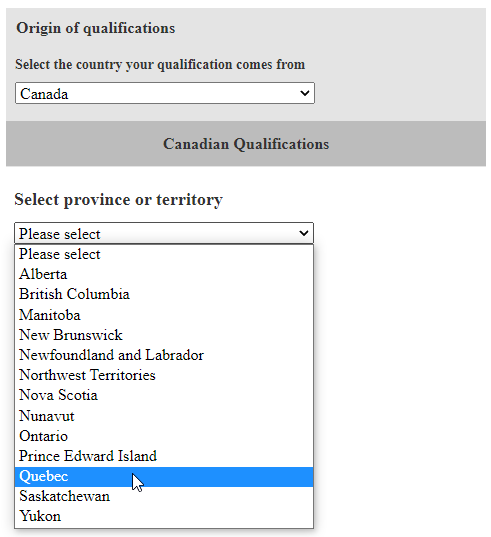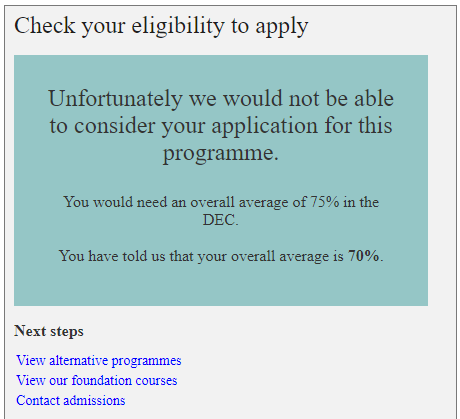Design sprint 4 & 5 research summary: entry requirements experiences
Our challenge for design sprints 4 and 5 was around the presentation of entry requirements. It’s such a big area we decided to dedicate two sprints. In sprint 4 we looked at provision for UK applicants (specifically widening access students) and in sprint 5 we looked at how we serve international students.
Our goal was to explore how we might empower applicants to understand their chances of application success regardless of the nature of the qualifications they hold or anticipate gaining.
In these sprints we set out to make it clearer the entry requirements a particular audience needs to meet by creating a degree programme page that allows a prospective student to tailor the information they see. In doing so they don’t have to read information relevant to others and determine whether it applies to them or not. In both sprints we created a prototype that presented entry requirement information in one place, removing the need to visit multiple web pages.
Entry requirements is a complex area. There are many qualifications across the world that we accept. But we’re a university with a lot of competition for places so it’s important that potential applicants can weigh up their chances of success.
We wanted to see how students would respond to a more tailored experience. Our assumption was that providing students with an opportunity to refine the information they saw would improve clarity and increase their satisfaction with the experience.
In this blog post I cover:
- Goals of the sprints and defining our sprint questions
- Summary of the user research and analysis we conducted
- Student needs
- Current experiences
- Experiences of designing prototypes and what we learned from user interviews
- Students participating in our widening access programme
- International undergraduate students
Setting goals and defining our sprint questions
Both sprints had the same aspirational long-term goal looking at what we would like to achieve over the long term with the sprint teams working towards the common goal together:
Applicants can be provided with a set of entry requirements that are tailored to their individual circumstances. They won’t need to visit multiple parts of the University web estate to locate the relevant information or decipher obscure terminology.
This means they will be able to easily see how well their experience and qualifications meet our requirements for consideration.
The goal was then turned into actionable items by rephrasing our assumptions and barriers into sprint questions.
- Can we provide only the information relevant to the individual?
- Can we ask the student to provide some information which we use to make a quick assessment and present a tailored answer? For example:
- determine whether they are eligible for Widening Access and if so tell them the minimum entry requirements
- determine whether they are from a country with some accepted institutions and some not and so suggest they get in touch
- Can we more publicly state the number of places and number of applications received?
- Can we be more open about the process for reviewing applications?
Students’ needs with entry requirements
Prospective students have a lot of important questions in relation to entry requirements. These are the biggest, cutting across all potential applicants:
- What do I need to apply for the degree I want to study?
Knowing what the entry requirements are, what they consist of (qualifications, required subjects, personal statement, reference, interview, tests, portfolio) and when to apply. - Which grades do I need to meet?
Understanding the difference between the categories of entry requirements and who they are aimed at. - How likely am I to get in? Is it worth applying here?
Appreciating how competitive entry is, the number of places available and what the selection criteria is so that applicants can apply in a way that maximises their chances. - I didn’t get the results I was predicted, what are my options?
Understanding what their options are when they don’t meet the entry requirements.
Students’ current experiences with entry requirements
Design sprints starts with understanding the problem space. We used a combination of methods to collect insights including interviewing colleagues in central, school and college admissions offices and reviewing quantitative data (admissions, enquiries and web analytics). We could also draw on discovery research conducted earlier this year to better understand the problems students face with entry requirements.
Key research findings
- Applicants need reassurance: Students regularly get in touch to be assured that they have the information pertinent to their personal circumstances to be considered for a place.
- Applicants don’t feel confident: Students often don’t feel confident they have found all the information they need on the University website.
- Terminology: The range of terms we use for categorising academic grades are different to those used by other Scottish universities. This inconsistency introduces further confusion in an already complex process. For example:
- Standard and minimum – University of Edinburgh
- Entry requirements and adjusted entry requirement – University of Glasgow
- Standard and widening access – University of Dundee
- Standard, Minimum and Adjusted – University of Aberdeen
- Standard, Minimum and Gateway entry requirements – University of St Andrews
- Distributed publication of information makes it hard to draw a conclusion: Information needed to establish entry criteria is not always well organised, whether on a single page or when published across multiple places. The journey to locate information is often circular. This means that the burden is on the applicant to read through all information instead of just what is relevant to them. This generates enquiries that admissions teams deal with repeatedly.
- English language requirements can be complex: A combination of the applicants’ nationality, country of study, curriculum and institution of study can meet the English language requirement without the need for a specific language test. For students who need a visa there is an English language requirement and it’s not always clear how this relates with the University requirement. Enquiries come from students asking about accepted tests and whether they can be accepted if their language certificate is a couple of weeks old.
Designing entry requirements for widening access students
Assessing the viability of our idea
We know from our research that the difference between standard and minimum entry requirements is unclear. Many students misunderstand who the minimum entry applies to and why.
Our design idea had to be clearer in articulating entry requirements, along with important information about:
- Competition for places
- Selection process
- Admissions statistics
We felt that by showing the number of applications made for a particular programme in the previous admissions cycle, we could help weaker potential applicants identify themselves independently. This could help to lower rates of unnecessary enquiries and applications from those that don’t meet the requirements.
We designed a feature that allows users to see only the entry requirements relating to the country that their qualifications come from. By default this was set to United Kingdom showing the main qualifications types: Scottish Highers, A Levels, and International Baccalaureate.

Showing origin of qualifications and the common British qualifications
On expanding the Scottish Highers we showed the grades and required subjects for the standard entry requirement only.
Below the standard entry requirements was a section that informed users about an adjusted offer of entry for widening access students, with an opportunity to check for eligibility. Our expectation was that this approach would be more clear than the current standard and minimum entry requirements.
This eligibility checker used a small amount of personal information to assess whether a person is eligible for support or an offer of non-standard entry requirements. In our internal language, a ‘flag’ or ‘plus flag’ applicant.
What we learned from interviews with prospective undergraduate students
When exposing students to this prototype, we wanted to understand whether they found the information sufficient, relevant and understandable.
Our participants were all involved in a widening participation programme that supports eligible secondary school pupils. Through these programmes pupils are made aware of the contextual offer available to people who live in the 20% most deprived areas in Scotland as indicated by the Scottish Index of Multiple Deprivation (SIMD) and attend a school with a lower progression to higher education.
While these support programmes exist we cannot expect every eligible applicant to have attended one. It is still important that our entry requirement information is clear and comprehensible to all. It’s also important that applicants who don’t meet eligibility criteria understand why adjusted offers are made.
Headline fingings:
- The eligibility checker was highly valued and was positively received having it all in one place within the entry requirements
- Participants were able to successfully move through the stages of the eligibility checker and easily make changes to their answers
- The result of the checker was clear when the student was eligible for a widening access offer (plus flag). The message of being eligible was appropriately structured with the adjusted minimum entry requirements
- The result of the checker when the student was not eligible (flag) confused some participants who wanted to clarify the factors that were taken into account. Being told they are not eligible and had to meet the standard entry requirements caused a cognitive burden where participants had to scroll back up the page to view the information.
- Although participants were familiar with an adjusted offer the terminology of ‘widening access’ was still a barrier to them in fully understanding the content.
- There was some concern that not everyone would identify themselves as a widening access student and would still want some reassurance that the adjusted entry requirements were applicable to them.
- Some participant’s wanted to see both sets of entry requirements (standard and minimum) because in their experience being part of a support programme they are told they are eligible and therefore wouldn’t need to go through a checker.
- Participants valued having information about the selection process as it gave them confidence in what they needed to achieve to be considered for a place.
- Having admissions statistics with the number of applications and the percentage of those accepted was useful to some but caused some worry that it might be off putting.
Student reactions to the prototype digital service we presented
I like how there’s something to help work this out for you… Having a straight up answer is helpful, telling you what the answer is, rather than a huge paragraph…
It’s very clear and helps you identify which category you’d fit into…
Designing entry requirements presentation for international students
Assessing the viability of our idea
As with the previous design sprint, our prototype presented entry requirements from the United Kingdom as default. Again, the participant was able to change this by selecting the country that their qualification came from.
The scenario we designed for was a Canadian with qualifications from Quebec. By selecting this we provided more tailored content with the equivalency of their international qualifications.

Tailoring the content to their qualifications
Underneath the entry requirements was a call-to-action button allowing users to complete a form to check whether they are eligible to apply for the programme there are looking at.

Start of the form to check whether eligible for apply
The form asks the following three questions:
- What is your nationality?
- Where do you live?
- What subjects are you studying and what grades do you have or expect to get?
When participants answered these questions in line with the scenario, they were notified that their qualifications did not meet the requirements for the programme. The prototype then presented options to view alternative programmes, look at foundation courses and contact admissions.

Results of the form with the message of not meeting the requirements
What we learned from interviews with current undergraduate students
We tested our prototype with 5 current international students.
Insights we gained through the testing were:
- Providing tailored content was helpful: participants highly valued the entry requirement equivalency of their international qualifications being shown on the programme page and contained the type of information they would expect.
- Participants were drawn to the eligibility checker: participants easily engaged with the eligibility checker and saw the value in being able to input their qualifications. Their initial expectation was that it would submit and register their interest in studying the programme with the relevant admissions team.
- A definitive result could be misleading: the result message of the eligibility checker was seen as a simplistic, generic statement which could be taken as an official rejection, deterring them from applying. They wanted far more specific information on how this was calculated.
- Guiding them through the process: when entering their grades it was important to some participants to distinguish which were confirmed and which were predicted. This meant that the result of the checker would feel less definite, and students felt more comfortable knowing that things can change.
- Expectation of links to alternative, eligible programmes: participants said they valued the offer of alternative programmes with the expectation that they would be able to discover similar programmes that they might not have considered, or known about, that meets their academic grades.
Next steps
Entry requirements is a top task for prospective students and one which generates a lot of enquiries. It’s essential that we continue to evolve the design ideas we tried out in these sprints if we are to support and understand their needs from different perspectives.
Using insights gained so far we will be able to make amendments to our prototype and conduct more testing with users from all audience groups. We need to reach out to first-time users of our website as it’s likely that their experience of the site with differ significantly from that of the recent and/or regular users that tested our initial ideas.
We learned that we are right to prioritise presenting tailored experiences to students if we want to reduce unnecessary enquiries and improve the overall levels of understanding among pre-applicants.
The fundamental ideas here, generated out of workshops with admissions specialists from across the University, are sound. We just need to improve and refine the presentation, wording and interactions present in these concepts.
But for now, we look ahead to our next design sprint which considers the scholarships experience.




